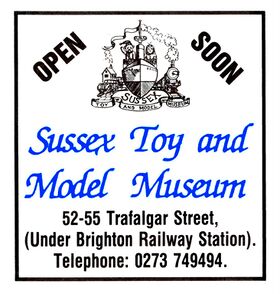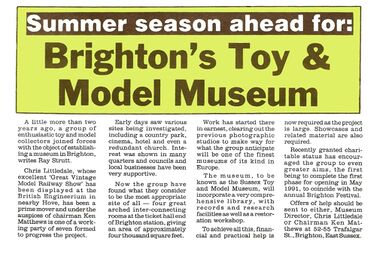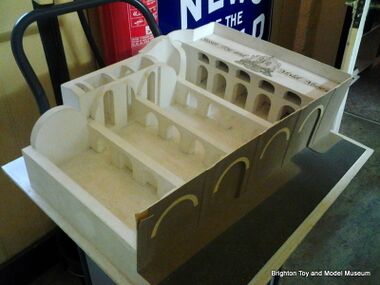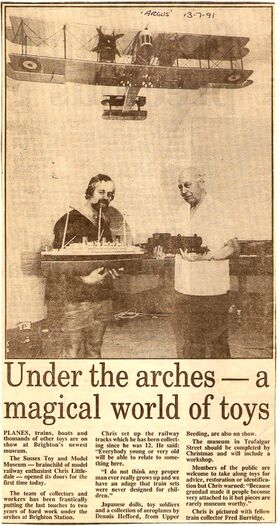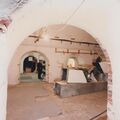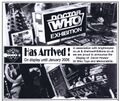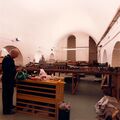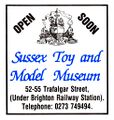Category:History of Brighton Toy and Model Museum
1991 April, "Coming Soon", advert in Collector's Gazette Issue 100 [image info]
1991 article in Collectors Gazette, on the expected opening of the new museum, scheduled for May 1991 [image info]
Reference model of the museum building used for planning, constructed by Chris Littledale [image info]
1991 July, article in The Argus about the new museum [image info]
The Museum was founded in 1991 by the current Director, Chris Littledale, an avid collector, model maker and restorer of models since he was twelve. He was assisted in this project by other Brighton collectors and modelmakers.
The Museum was officially opened in its current location in Trafalgar Street, under the arches below Brighton Station, on the 10th August 1991, and will be celebrating its quarter-century anniversary in 2016.
Since then it has developed one of the finest collections of toys and models up until the mid-C20th, including examples from the World's top toymakers.
A Potted History of The Museum (adapted from an article in the 2012 newsletter)
By 1991 it had long been in the mind of Chris Littledale to establish a gallery or museum in which to house his ever-increasing collection, a place to share and display these treasures.
1988 saw the birth of an idea. During his model railway show at the British Engineerium Museum in Hove, Chris met Ken Mathews a local hotelier and, with the enthusiastic co-operation of retired ophthalmic surgeon Michael Gilkes and others, including electrical engineer Fred Burridge and Roger Tuffin, our accountant to be, regular meetings were held at Ken Mathews’ "Arlanda Hotel" in New Steine, Brighton.
A Constitution was formed with five Trustees, a feasibility study made and charitable status achieved. The title of "The Sussex Toy and Model Museum" was used, as at that time no premises were forthcoming and the title "Sussex" would cover our eventual home in the area. Despite constant searching, we had no home. We searched on foot and through all the local resources, including redundant churches, cinemas and various other buildings.
Rebuilding the site
Eventually and unexpectedly in November 1990 Chris came upon a British Rail Property Board "Premises To Let" notice under Brighton Station in the Trafalgar Street bridge under-croft.
Our project was accepted and before Christmas of that year we had tenancy and the premises of our dreams! Close inspection however revealed an unbelievable task ahead, both financially and physically. The four barrel-vaulted arches were in a very bad state, with various brick infills, rough unfinished floors, no proper steps and in need of complete rewiring. The four arch faces at street level had been primitively in filled over many years and were totally unacceptable from our insurer’s point of view. To add to all the problems was a huge quantity of junk, material and internal partitions. The bottom easterly arch was also home to an open drain and a dished cobbled floor, no doubt from early beginnings in the 19th Century, when the arches were home to Bass beer stores, in which the horse drawn dray would be unloaded, the horses turned and some stabled ready for a return journey process. This arch also had five smaller sub-arches, incorporating secondary upper half arches with square openings to below, these being the hay lofts for the resident horses.
Everywhere you looked the paint and renders were breaking and flaking, toilet and plumbing needed complete replacement and upgrading. How the previous tenants managed here is difficult to imagine. They ran a successful photographic studio, before moving house to Lewes. We, the museum gang, took up the challenge and, late in 1990, having obtained keys and electricity, the fun "at the beginning" started. We really loved our new home, but the task ahead was truly daunting.
Coincidentally, at the time of our occupation, Trafalgar House, a large office building complex, had started on land immediately to the east and on the site of the old lower goods yard to Brighton Station. Ken Mathews, then Chairman of the Sussex Toy and Model Museum Trust, was a pillar of strength in many different ways. He went in a truly neighbourly spirit to Faircloughs, our next door contractors of the Trafalgar House development, and talked them into donating a quantity of various building materials to our charitable status museum. Within two weeks forklift trucks were filling our largest easterly arch with pallets of breeze blocks and thousands of bricks. We were now Site II on their building plan.
The blocks and bricks were all very well, but somehow we had to stick them together. Ken in his wisdom called on Faircloughs and asked for a cement-mixing source, together with some bricklaying advice. The result was unlimited use of one of their cement mixers, wall ties and a young bricklayer called Garry. We demolished the primitive street level arch infills and bricking-up commenced. Chris and the team, including Ken, Michael Gilkes, "Irish Jim", Chris’s brother Trevor and others, helped with cement-moving, clearing out, demolition and other endless tasks. Proper exit and entry porches were designed for the project and meanwhile Fred Burridge, our qualified electrical engineer, was completely rewiring the entire premises in pyro fire-retarding cable. This he managed to obtain, through contacts, as a donation. The Museum developed on a shoestring and it took some three months to scrape and paint all the surfaces. Chris worked endless days and into the nights with the use of a scaffold tower. This was extremely exhausting and rather depressing.
The interior
At this time Peter Palmer, working with the airlines, started regular help.
We finally equipped the premises, starting with the magnificent "0 gauge" central layout. We obtained all sorts of shop counters, glazed cupboards, shelves and a large jeweller’s mirror-backed showcase. With Denis Hefford’s aeroplanes suspended and a rudimentary counter and till we opened to the public during August 1991 and, exhausted, we celebrated. An unbelievable series of changes and traumas have followed and success has won over.
Establishment
The interim years have been truly fraught with all sorts of problems, finance, bank loan, management, staffing and to add insult to injury, an extremely worrying water ingress problem, brought on by the sub contractors relaying the forecourt under the station canopy above us. The workmen managed to fill some sump drains with hardcore and damage the already fragile gullies and surface storm water drains. The result was nearly closure of the Museum. This problem, however, was rectified at great expense to the landlords, and more or less worked and we coasted along until the tide turned some in around 2009.
Brighton and Hove Council recognised our importance from a cultural and tourist point of view. We became the official information centre for Visit Brighton, and so became the anchor at the station end of the newly promoted cultural route to the sea. During this period we also managed, through the Railway Heritage Trust and Janita Bagshawe at the Royal Pavilion, to convince our landlords, Network Rail, of our unique educational and cultural importance and to secure our future success we were given a much longer 15 year lease at a rent we could afford. From then on our landlords have been supportive and indeed one of our team of sponsors. In the same period we at the Museum achieved MLA accreditation. This was the result of endless hard and tedious administrative work.
To date we can boast 22 commercial sponsors. Anthony Bianco has been an invaluable tower of strength throughout all these initiatives and we have secured some impressive funding to achieve our renaissance. Long may it continue.
— -, -, -
Pages in category ‘History of Brighton Toy and Model Museum’
The following 2 pages are in this category, out of 2 total.
Media in category ‘History of Brighton Toy and Model Museum’
The following 9 files are in this category, out of 9 total.
- 1991-03 article, Collectors Gazette, front page.jpg 1,346 × 898; 265 KB
- 1991-07 Under the arches – a magical world of toys (The Argus).jpg 959 × 1,800; 1.39 MB
- Chris Littledale, museum construction.jpg 2,000 × 2,000; 580 KB
- Collectors Gazette, October 1989.jpg 1,649 × 2,200; 953 KB
- Doctor Who Exhibition has arrived, 2005.jpg 1,600 × 1,352; 658 KB
- Fred Burridge and Chris Littledale, museum construction.jpg 1,999 × 2,000; 672 KB
- Making History Fun Logo.gif 110 × 77; 3 KB
- Sussex Toy and Model Museum, Brighton, Opening Soon (CollGaz 1991-04).jpg 975 × 1,024; 196 KB
